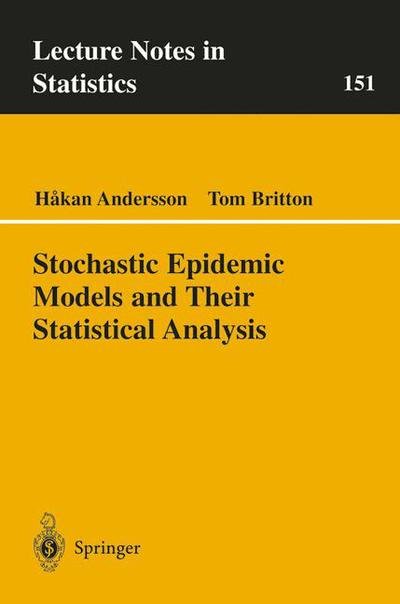
Recomienda este artículo a tus amigos:
Stochastic Epidemic Models and Their Statistical Analysis 2000 edition
Hakan Andersson
Stochastic Epidemic Models and Their Statistical Analysis 2000 edition
Hakan Andersson
The present lecture notes describe stochastic epidemic models and methods for their statistical analysis. The reader of these lecture notes could thus have a two-fold purpose in mind: to learn about epidemic models and their statistical analysis, and/or to learn and apply techniques in probability and statistics.
Marc Notes: Includes bibliographical references (p. [128]-133) and index. Table of Contents: I: Stochastic Modelling.- 1. Introduction.- 1.1. Stochastic versus deterministic models.- 1.2. A simple epidemic model: The Reed-Frost model.- 1.3. Stochastic epidemics in large communities.- 1.4. History of epidemic modelling.- Exercises.- 2. The standard SIR epidemic model.- 2.1. Definition of the model.- 2.2. The Sellke construction.- 2.3. The Markovian case.- 2.4. Exact results.- Exercises.- 3. Coupling methods.- 3.1. First examples.- 3.2. Definition of coupling.- 3.3. Applications to epidemics.- Exercises.- 4. The threshold limit theorem.- 4.1. The imbedded process.- 4.2. Preliminary convergence results.- 4.3. The casemn/n > 0 asn? ?.- 4.4. The casemn=mfor alln.- 4.5. Duration of the Markovian SIR epidemic.- Exercises.- 5. Density dependent jump Markov processes.- 5.1. An example: A simple birth and death process.- 5.2. The general model.- 5.3. The Law of Large Numbers.- 5.4. The Central Limit Theorem.- 5.5. Applications to epidemic models.- Exercises.- 6. Multitype epidemics.- 6.1. The standard SIR multitype epidemic model.- 6.2. Large population limits.- 6.3. Household model.- 6.4. Comparing equal and varying susceptibility.- Exercises.- 7. Epidemics and graphs.- 7.1. Random graph interpretation.- 7.2. Constant infectious period.- 7.3. Epidemics and social networks.- 7.4. The two-dimensional lattice.- Exercises.- 8. Models for endemic diseases.- 8.1. The SIR model with demography.- 8.2. The SIS model.- Exercises.- II: Estimation.- 9. Complete observation of the epidemic process.- 9.1. Martingales and log-likelihoods of counting processes.- 9.2. ML-estimation for the standard SIR epidemic.- Exercises.- 10. Estimation in partially observed epidemics.- 10.1. Estimation based on martingale methods.- 10.2. Estimation based on the EM-algorithm.- Exercises.- 11. Markov Chain Monte Carlo methods.- 11.1. Description of the techniques.- 11.2. Important examples.- 11.3. Practical implementation issues.- 11.4. Bayesian inference for epidemics.- Exercises.- 12. Vaccination.- 12.1. Estimating vaccination policies based on one epidemic.- 12.2. Estimating vaccination policies for endemic diseases.- 12.3. Estimation of vaccine efficacy.- Exercises.- References. Publisher Marketing: This book describes stochastic epidemic models and methods for statistically analyzing them. It is aimed at statisticians, biostatisticians, and biomathematicians.
Contributor Bio: Britton, Tom Britton is the former CEO of a top-rated Houston bank and former two-term chairman of the Houston Northwest Chamber of Commerce. He is also a magician.
| Medios de comunicación | Libros Book |
| Publicado | 19 de julio de 2000 |
| ISBN13 | 9780387950501 |
| Editores | Springer-Verlag New York Inc. |
| Páginas | 156 |
| Dimensiones | 155 × 235 × 8 mm · 226 g |
Ver todo de Hakan Andersson ( Ej. Bound Book y Book )

